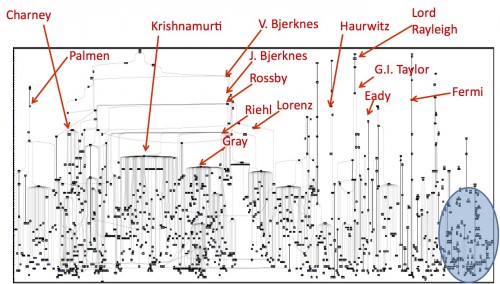For history buffs, YouTube is an incredibly addictive site. Are you a football fan? Maybe you’d like to watch some highlights from games played in 1976. More of a rock ‘n roll enthusiast? Check out the remastered version of the Beatles’ legendary appearance on the Ed Sullivan Show in 1964. But if you’re interested in the history of the atmospheric sciences, maybe you’ve been wondering where you can get your video fix. Now NCAR has the answer: their new YouTube channel. The channel is part of the NCAR/UCAR Archives, which has more than 70 collections in both paper and digital form. NCAR’s Kate Legg highlighted some of the organization’s digital archive highlights in Tuesday’s session on historical perspectives on weather.
The NCAR YouTube channel includes a number of 16-mm films made in the 1960s and 1970s, including scenes from various field projects and educational videos that Legg noted “remind her of film projectors and elementary school.” The channel currently has 30 videos, with new material added on a regular basis. The sample video below was made for the National Scientific Balloon Facility.
ASLI Chooses the Best Books of the Year
The Atmospheric Science Librarians International (ASLI) announced their ASLI Choice Award winners for 2012 on Wednesday afternoon at the ASLI exhibit. The awards, now in their eighth year, are presented for the best books of the year in the atmospheric sciences and are judged in the following criteria: uniqueness, comprehensiveness, usefulness, quality, authoritativeness, organization, illustrations/diagrams, competition, and references.
Awards were given in four categories: science, history, popular, and reference (a new category this year), and in one case a series was honored rather than a book. The winners by category are:
Science
The Future of the World’s Climate (Second Edition), edited by Ann Henderson-Sellers and Kendal McGuffie, published by Elsevier, 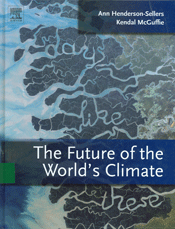 chosen for “the broad scientific context that it provides for current efforts to model and predict climate change.”
chosen for “the broad scientific context that it provides for current efforts to model and predict climate change.”
Honorable mention–Atmospheric Physics: Background–Methods–Trends, edited by Ulrich Schumann, published by Springer, for its “up-to-date essays on facets of the atmosphere, the methods and instruments used to conduct research in the field, and upcoming research trends.”
History
Hawai’i’s Mauna Loa Observatory: Fifty Years of Monitoring the Atmosphere, by Forrest M. Mims III, published by the University of Hawai’i Press, 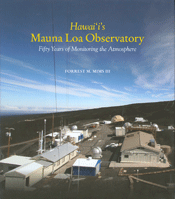 for “its engaging perspective on the scientists, discoveries, and ground-breaking atmospheric measurements done at Mauna Loa Observatory.”
for “its engaging perspective on the scientists, discoveries, and ground-breaking atmospheric measurements done at Mauna Loa Observatory.”
Honorable mentions–Lake Effect: Tales of Large Lakes, Arctic Winds, and Recurrent Snows, by Mark Monmonier, published by Syracuse University Press, for “its clear and accessible examination of lake-effect snow, a regionally important meteorological phenomenon, and how it has shaped the history of the Great Lakes region”; History of the Meteorological Office, by Malcolm Walker, published by Cambridge University Press, for “a thorough account of the scientists, science, and achievements of the Met Office from its earliest beginnings to the present day”; and The Discovery of Weather: Stephen Saxby, the Tumultuous Birth of Weather Forecasting, and Saxby’s Gale of 1869, by Jerry Lockett, published by Formac Publishing, for “a readable history of the evolution of weather forecasting, the Gale of 1869, and Saxby’s prediction of the storm.”
Reference
The Atmospheric Chemist’s Companion: Numerical Data for Use in the Atmospheric Sciences, by Peter Warneck and Jonathan Williams, 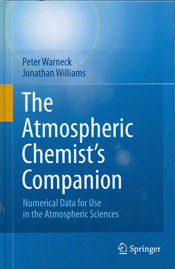 published by Springer, for “its well-organized assembly of frequently needed numerical data and measurement techniques.”
published by Springer, for “its well-organized assembly of frequently needed numerical data and measurement techniques.”
Honorable mention–Kinikmi Sigum Qanuq Ilitaavut–Wales Inupiaq Sea Ice Dictionary, compiled by Winton Weyapuk Jr. and Igor Krupnik, edited by Igor Krupnik, Herbert Anungazuk, and Matthew Druckenmiller, published by the Smithsonian Institution, for “preserving, documenting, and illustrating the terms for sea ice and associated phenomena in the Kingikmiut dialect.”
Popular
Princeton Primers in Climate series, edited by Alison Kalett, published by Princeton University Press, for “for brief, readable books on key topics in climate science that provide essential knowledge and point to further investigation.”
Congratulations to all the winners! Go to the ASLI Choice Award page to find out how to nominate a book for the 2013 awards.
2013 Recipient of Biometeorology Award Aims to Resolve Complex Boundary Layer Interactions
Thomas Foken, professor of micrometeorology at the University of Bayreuth Center of Ecology and Environmental Research in Bayreuth, Germany, is the 2013 recipient of the AMS Award for Outstanding Achievement in Biometeorology. Specifically, Dr. Foken received this award for many contributions, as a researcher and educator, to the understanding and measurement of atmosphere-biosphere interactions and the surface energy balance.
The Front Page caught up with Dr. Foken at the 2013 Annual Meeting in Austin, Texas, to find out more about his research, including his interests in micrometeorology. His described this area of our science as the physics and chemistry of the boundary layer, which encompasses the lowest portion of atmosphere, and the complicated interactions among plants, soils, the oceans, and the atmosphere. He adds that micrometeorologists investigate all the parameters in the global models that are part of this small-scale environment, known as the biosphere or ecosphere. Moreover, he defines biometeorology as an interdisciplinary science that brings meteorologists, soil scientists, and biologists together to better understand the processes that define all of these small-scale interactions so the problems they present within the models can be resolved.
Click on the image below to view the interview.
Broadcast Meteorologist Explains the Climate Change Impacts Already Affecting His Viewers
Chief Meteorologist Jim Gandy of the Columbia, South Carolina, CBS affiliate station WLTX-TV is the 2013 recipient of the AMS Award For Excellence in Science Reporting by a Broadcast Meteorologist. Mr. Gandy received the award and recognition for pioneering efforts to educate viewers about climate change and explaining how it already affects them.
In an interview with the AMS, Mr. Gandy explains how he developed a climate change segment for his Weathercasts called Climate Matters. Each segment focuses on an aspect of climate change that is already showing up where viewers live, work, and play. The Climate Matters stories, including the segment about Poison Ivy and Climate Change that won him the award are posted online for not just his viewers but everyone to watch. He also mentions that the favorable response from his viewers about the segments sparked the creation of a blog for the station he similarly named Weather and Climate Matter.
Click on the image below to view the interview. (Please note that the video portion of the interview has a bit of a lag, and for that we apologize; the audio itself is clear.)
Investigating Tornado Fatalities
Men, particularly the elderly, die at a disproportionately higher rate than other population groups. It’s a well-known fact to those studying tornado fatalities, but what researchers are trying to find is a way to keep more of these high risk men responsive to alerts and therefore save lives.
Wednesday morning at the AMS Annual Meeting, several researchers discussed their research on tornado fatalities. The policy session, chaired by Kimberly E. Klockow of the University of Oklahoma, showed that social sciences and data collection methods are improving the way we can analyze deadly storms and adequately warn the public before these storms strike.
Amber Cannon of the University of Oklahoma started the discussion with a comparison of data from tornado outbreaks in Alabama on 3 April 1974 and 27 April 2011. She noted that, although more people died in the 2011 outbreaks than in 1974, the population density had increased during that time. As a result, the fatality rates very similar.
If the death rate isn’t going up, then maybe we can bring it down. Shadya Sanders, from Howard University, presented her research regarding the super outbreak of tornadoes in 2011. She found that, while a 45% tornado risk seems huge to a meteorologist, the average person may not see the gravity of such a situation. Her work with focus groups has shown the importance of education for children and risk awareness for adults.
Soon, according to Hope-Anne Weldon of the University of Oklahoma, there will be a “one-stop shop” for killer tornado information from the NOAA/NWS Storm Prediction Center. Weldon spent an entire summer filling in gaps in data about tornado victims, clarifying tags of age, gender, and domicile in statistics for 1991-2010–in all 400 tornadoes killing more than 1,100 people. With more detailed data, she noted, social scientists will be able to draw even better conclusions.
The Year by the Numbers
Here’s a statistic for you: 3,300.
That’s the number of attendees (as of Tuesday) at this AMS Annual Meeting.
Here’s another: 1,000.
That’s the lower estimate of attendance at our WeatherFest here in Austin on Sunday.
Here’s another: 2013.
No, that’s not the number of umbrellas sold to meteorologists in downtown Austin yesterday; that’s the year, which happens to be the International Year of Statistics. The American Statistical Association (ASA) and more than 1,400 organizations in 111 countries are combining energies in 2013 to promote statistics. “Statistics2013” will highlight the contributions of the statistics field to finding solutions to global challenges.
“For most people, statistics is an invisible science,” says Ronald Wasserstein, executive director of the American Statistical Association. “Through this yearlong, worldwide awareness campaign, we will remove the veil that cloaks statistics from the public consciousness.”
Such awareness is not difficult to acquire through the programming of the week’s meeting in Austin, with sessions on characterizing uncertainties, data assimilation, Big Data, climate trends, radar algorithms, and so much more. But there’s no better way to kick off Statistics2013 than to attend tomorrow’s poster session (9:45 a.m.) for the Symposium on the Role of Statistical Methods in Weather and Climate Prediction. Bias correction, microphysics parameterization, statistical downscaling, model postprocessing–it’s Gauss in Wonderland.
From the Statistics2013 website:
When many people hear the word “statistics,” they think of either sports-related numbers or the college class they took and barely passed. While statistics can be thought about in these terms, there is more to the relationship between you and statistics than you probably imagine.
And here’s that number, again: 3,300…that’s how many people here at the Austin Convention Center who would heartily agree.
Scenes from the Annual and Austin
The meeting may still be in full swing but it’s not too early to take a look back at some highlights of the past few days. Check out AMS’s flickr page for photos of the student conference, WeatherFest, Keep Austin Beautiful, the Exhibit Hall, and attendees in action. You might even see yourself in one.
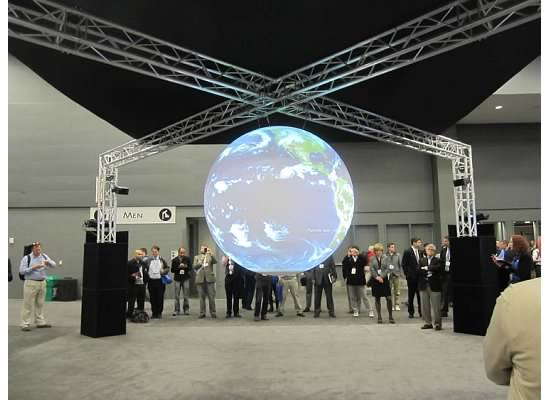
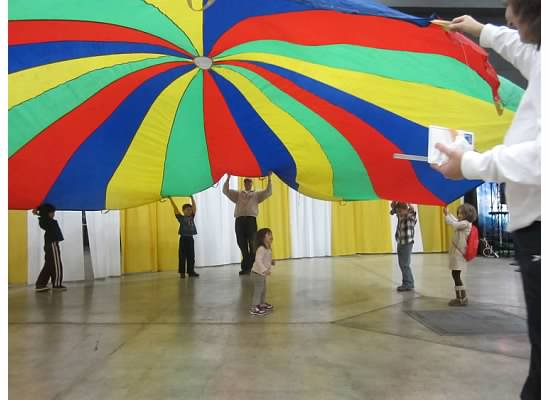
Go to flickr to see more and be sure to check back regularly for additions.
2013 Carl-Gustaf Rossby Award Recipient Strives to Deepen Our Grasp of Earth's Climate System
Dennis L. Hartmann, professor of atmospheric sciences at the University of Washington, is the 2013 recipient of the prestigious Carl-Gustaf Rossby Research Medal—meteorology’s highest honor. Dr. Hartmann is receiving this distinctive award for his significant contributions to the synthesis of knowledge of radiative and dynamical processes leading to a deeper understanding of the climate system.
The Front Page spoke with Dr. Hartmann to learn about his research and how it has evolved and become more interdisciplinary as climate change has grown increasingly important. He explained that he now focuses more on trying to understand Earth’s climate system, blending the traditional disciplines in the atmospheric sciences—radiation, dynamics, and cloud physics and chemistry—because, he said, “they are so interconnected on the long time scales associated with climate change.” With advances in technology, Dr. Hartmann utilized more and better remote sensing data from satellites to make improvements in modeling Earth’s climate—in particular, the approximate interactions between clouds and the global circulation.
“The one thing that I’ve tried to do is to look for simple, fundamental explanations for how things work and that gives us more confidence in the rather complex simulations that we do with global models.”
Click on the image below to view the interview.
2013 Jule G. Charney Award Recipient has an Out-of-this-World View of Earth's Circulations
Alan Plumb, professor of meteorology at the Massachusetts Institute of Technology (MIT), is the 2013 recipient of the prized Jule G. Charney Award. Dr. Plumb is being honored with this award, which is in the form of a medallion, for fundamental contributions to the understanding of geophysical fluid dynamics, stratospheric dynamics, chemical transport, and the general circulation of the atmosphere and oceans.
The Front Page spoke with Dr. Plumb to learn more about his research, including his interests in the dynamics of Earth’s atmosphere as well as the atmospheres of other planets. Though he now mostly focuses on Earth’s circulations, he mentioned that his PhD thesis was on the atmosphere of Venus and interactions of waves on its circulation. More recently, he has been focused on understanding how gravity waves interact with our stratosphere.
Click on the image below to view the interview.
Tropical Meteorology: All in the (Very Big) Family
It’s normal to run into familiar faces in Austin this week–that’s what an AMS Meeting is all about. But running into your parents, your children, well that’s no so common.
Or is it? At Florida State Robert Hart and Josh Cossuth have been getting back to their roots, and embarked on a project to map the entire family of tropical meteorology, tracing lineage back to Bjerknes, Rossby and others. The tree of relations they present this afternoon (Room 19B, 4:15 pm) is intricate and rapidly expanding, with hundreds and hundreds of meteorologists on it. Chances are you may be on it, too.
It can’t feel bad to know you have professional cousins descended from Lord Rayleigh, or that you’re a relative of Enrico Fermi.
You’re with family here at AMS.
